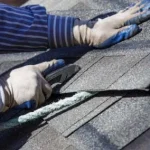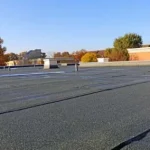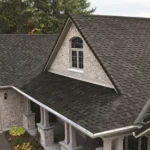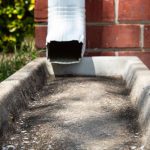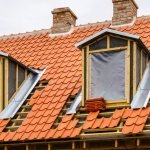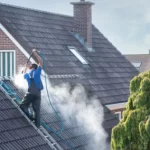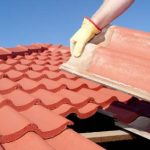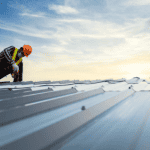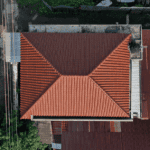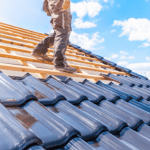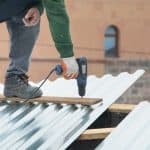
A Quick-Step Guide to Home Roofs
Roofs play a significant role in home architecture because they blend aesthetics and functionality. It not only protects the house but creates an impression on the visitors. Slope, also known as ”roof pitch,” creates a significant impact on the house’s functionality and appearance.
Dive into our guide to figure out the essential components that need to be kept in mind while choosing a slope. Explore how future circumstances with it can be avoided while maintaining your budget. Let’s rise and run with us while crafting comfort from crest to eave.
What is Roof Pitch?
The angle artistry of rise and run determines the slope scope. ‘Pitch’ is the height or slope of a roof. This tells you how much a roof will rise for every 12 inches of depth. A ”4 in 12” sloped roof will rise 4 inches vertically and run 12 inches in the horizontal direction. This examines everything, especially roof material that analyzes the roof’s strength even in the snowy and rainy season.
The Importance of the Roof Pitch
Before we dive into the comprehensive guide to choosing the best material, let’s first explore what Roof Pitch means. Increasing the roof pitch, which is the height of a roof, helps increase its lifespan. It lessens the chances of accumulation of snow or debris, which could heavily affect its durability.
Choosing the construction of a roof pitch with a higher slope means it will consume more significant construction costs and more time, material, and labor effort. This means repairs take a bit longer, too. However, low slopes get damaged easily and end up with water damage or leakage, but they are easier to maintain and repair roof.
Identify the Typical Roof Pitch
For residential structures, 4/12 to 9/12 are considered a common category. This category brings profitability, space functionality, and aesthetic appeal. But, what ‘typical’ makes up is based on various characteristics such as climate, personal preference, and regional structure style.
Regional and Climatic Considerations
High-pitched roofs are commonly found in snow-prone regions, such as the Northeast or the mountainous areas. The mechanism behind this is simple. Gravity pulls the snow and pulls down slopes, reducing the load on the surface of it. Places where there is less snow have smoother slope roofs. It’s always convenient to perform maintenance and construction of such roof pitches.
The 4/12 Slope: A Common Standard
4/12 slopes are the initial preference for many houses. It’s cheap and easy to maintain. Also, it’s steep enough to shed rain and snow without causing any harm to the structure. Many brands offer the best material even in 4/12 pitch at the cheapest prices.
Moving to a Steeper 9/12 Pitch
This is the most traditional design in the 9/12 roof deck. It provides a royal touch with its crisp angles. Steeper slopes are an ideal choice to gain a spacious living space. However, increasing the slope height requires more labor effort, cost for material, and time. This is an essential point while making your choice for a pitch.
The Modern Take: Varying Pitch for Aesthetics and Function
In contemporary architecture, the roof slope adds charm to the artistic element of the house rather than contributing to practical factors. Architectures can add detail to the modern appearance by combining the flat surface with the sharp peaks. Also, they can change the structure by blending the different shapes to form an exciting one.
Materials and Roof Pitch Consideration
Choosing a suitable material influences the lifespan of the roof pitch. For example, Traditional shingles are not ideal for low slopes as they may lead to water invasion. However, some metal roofing materials work well on pitched roofs.
When Repairing Your Roof: Pitch Matters
When choosing to repair your roof, the location has a significant impact on the cost of its maintenance. A higher roof requires more men’s power than the steeper ones. This not only increases the roofing maintenance cost but consumes more time as well. It’s always recommended to look for a roofer who knows the ins and outs of your specific roof slope.
Is There an Ideal Roof Pitch?
An ideal roof keeps a balance in all aspects. Whether it is an architectural style, climate, personal preference, or financial constraints, the one that maintains a perfect balance is the best fit for the roof pitch. Even in the same region, a house’s roof slope may vary, as it’s all about your preference.
A roof height that balances the home’s architectural style, climate, individual preferences, and financial constraints is ideal. Even within the same neighborhood, a house’s typical roof slope can differ significantly from another’s. It all comes down to striking the perfect balance in your unique circumstance.
A roof height that balances the home’s architectural style, climate, individual preferences, and financial constraints is ideal. Even within the same neighborhood, a house’s typical roof slope can differ significantly from another’s. It all comes down to striking the perfect balance in your unique circumstance.
Is Your Research Thorough Enough to Guarantee the Best Roof Decision?
Making a wise decision while choosing the slope is essential as it decides the future circumstances and their cost. Even with an extensive range, there are a few factors that need to be considered while choosing your roof, including area preference, climatic changes, and structural needs of the property.
After comprehensive research, you can make the best decision. By being aware of the intricacies, it’s easier to design your home with complete functionality. This is an investment for your house’s future to ensure its safety and comfort for extended periods.
We are here to bring the best solution at your fingertips. Reach out today to learn further with us.





